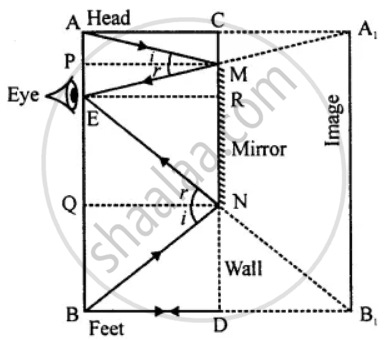Advertisements
Advertisements
Question
What must be the minimum length of a plane mirror in which a person can see himself full length? Draw a diagram to justify your answer. Does the distance of a person from the mirror affect the above answer?
Solution
Minimum Height Of Plane Mirror Required For A Person To See Full Length Consider a person AB, such that A represents the highest point on his head, and B the lowest point on the foot such that E is the fixed eye level (see figure). The person will be able to see every part of his body if the can see points A and B. Let MN be the minimum length of mirror fixed on the wall, such that the rays AM and BN, after reflection, reach the eye of person, thereby forming an image A1B1 when produced backward.

In ∆AEA1, CM is parallel to AE and C is the mid-point of AA1. M is the mid-point of A1E.
Similarly, in ∆BEB1, ND is parallel to BE and D is the mid-point of BB1
∴ N in the mid-point of B1E.
Now in ∆A1B1E, M is mid-point of A1E and N is mid-point of B1E.
∴ MN is parallel and half of A1B1
But, A1B1 = AB
So, MN = 1/2 AB.
Thus, in order to see the full length, a person requires a plane mirror which is half his own height. This relation is true for any distance of the object from a plane mirror.
APPEARS IN
RELATED QUESTIONS
Write true or false of the following statement.
When a light ray is reflected from a wall, the angle of incidence is not equal to the angle of reflection.
Fill in the blank
The image formed by a plane mirror is erect and _____
How many images are formed for a point object kept in between two plane mirrors at right angles to each other? Show them by drawing a ray diagram.
By drawing a neat diagram define the following:
Mirror
State the mirror formula for the formation of total number of images formed in two plane mirrors, held at an angle.
What should be the minimum size of a plane mirror, so that a person 182 cm high can see himself completely?
A boy stands 4 m away from the plane mirror. If the boy moves `1/2` m towards the mirror, what is now the distance between the boy and his image? Give a reason for your answer.
An insect is sitting in front of a plane mirror at a distance of one meter from it.
- Where is the image of insect formed?
- What is the distance between insect and its image?
- State any two characteristics of image formed in a plane mirror.
Parallel rays are incident:
- on regular surface and
- on irregular surface. In what respect do reflected rays in (1) differ from those of (2)?
Select the correct option:
A ray of light is incident on a concave mirror. If it is parallel to principal axis, the reflected ray will:
